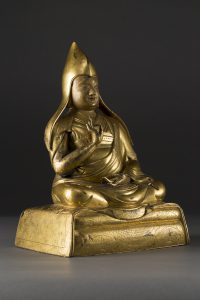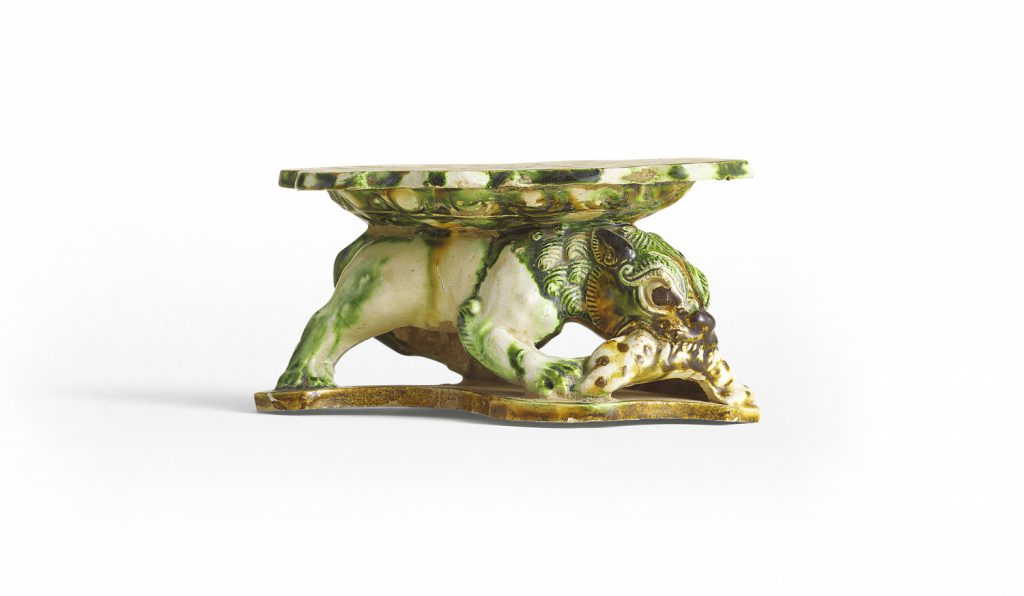Asia Week New York
‘Treasures from China’s Past’
15-22 March 2019
Exhibiting at:
Daniel Crouch Rare Books
24 East 64th Street, 2nd floor
New York 10065
Focal point of our exhibition ’Treasures of China’s Past’ will be important works of art from private collections dating from the Northern Wei to the Qing dynasty.
Highlights include an exceptional Northern Wei head, a rare Tang dynasty chestnut-glazed pottery horse, an impressive Liao dynasty green and straw-glazed pottery watch tower, a 18th century gilt bronze figure of Gelugpa Lama and a large gilt bronze Buddha dating to the mid Ming dynasty.
These will be shown alongside an important group of museum worthy three-coloured ‘sancai’ wares, previously in the collection of the famous Hong Kong dealer and collector Susan Chen (‘Sze Yuan Tang Collection’).
A rare ‘sancai’ glazed lion pillow (Tang Dynasty, 8th century)
Dimensions: width 14.5 cm, 5 7/10 in
Provenance:
The Sze Yuan Tang Collection, Hong Kong
Published:
‘The Splendour of Sancai – The Sze Yuan Tang Collection’
Compare a similar example at the Victoria & Albert Museum, London
This rare ‘sancai’ glazed lion pillow (Tang Dynasty, 8th century, 14.5cm wide) is one of the best examples of animal pillows to have survived from the Tang Dynasty. Created in the 8th century at the height of the Dynasty, it vividly depicts a hunting lion devouring its pray. Unlike other pillows of this type that normally show static animals, this pillow successfully captures the vitality and ferociousness of a hunting lion.
The naturalistic modeling is enhanced by the well controlled use of the three-coloured (san cai) glaze, highlighting the features of the animal and adding drama to the scene. It shows how the potters of the 8th century had mastered the use of coloured glazing and were able to incorporate it successfully in their designs. The lion is a sacred animal in Buddhism, and is regarded as the guardian of Buddhist law. Its roar is an analogy of the spreading of Buddha’s teaching, as well as the quelling of evil. As lions are not indigenous to China, the Tang potters were unlikely to have seen one, even though there are records of lions being given as gifts to the Tang court. The Chinese character for lion, furthermore, is written with the particle for ‘dog’, indicating it is part of the canine family in the Chinese mind. It is therefore not surprising that when we see models of Tang lions, they often seem more canine then feline.
An impressive green and straw-glazed pottery watch tower (Liao Dynasty, 907-1125 AD)
Dimensions: height 115 cm, 45 3/10 in
Provenance:
A Dutch private collection
An English private collection, purchased in Hong Kong in the 1990s
Multi-storied towers such as this one can first be found in tombs of the Eastern Han Dynasty (25-220 AD), in north central China. They evoke the appearance of a new building type, a stand-alone tower designed to serve as a pavilion or watch tower for pleasure and entertainment, constructed in wood, plaster and tile.
The current example is especially rare as it dates to the Liao Dynasty and is executed in a ‘sancai’ glaze. The different lose elements are carefully arranged to form this delicate structure.
A chestnut-glazed Tang pottery horse (Tang Dynasty, 618-906 AD)
Dimensions: height 83 cm, 32 7/10 in
Provenance:
A Dutch private collection
An English private collection, purchased in Hong Kong in the 1990s


An important gilt bronze figure of Gelugpa Lama (18th century)
Dimensions: height 25.5 cm, 10 in.
Provenance:
Lingero Collection Brussels -before 1975
Claude de Marteau Collection Brussels 1975 – 1982
Yvergneau Collection Antwerp 1982 – 2014
A large gilt bronze Buddha (Ming Dynasty, 16th Century)
Dimensions: height 39 cm, 15 2/5 in.
Provenance:
From the collection of Dr. Schoorens, Belgium. Acquired in Hong Kong 1989
An important silver gilt ewer (Liao Dynasty, 10th century)
Dimensions: height 16.5 cm, 6 ½ in.
Provenance:
Acquired in Hong Kong 1997
A private Asian collection
A silver gilt ewer of fine workmanship, richly gilded and decorated with designs that are raised, incised and punched.
A powerful bird headed mythical winged creature with the body of a dragon is depicted on the top of the ewer, with the birds’ head forming the spout.
Accompanying this bird like creature are two other mythical birds Phoenix, are shown in flight with outstretched wings and long flowing tails. They fly above long stemmed vine like plants, and amongst cloud patterns. Floral patterns decorate the handle and the cover, whilst the base of the ewer is decorated with a design of upturned lotus leaves.
A silver Gilt Container (Liao Dynasty 10th century)
Dimensions: diameter 12 cm, 4 7/10 in.
Provenance:
Acquired in Hong Kong 1997
A private Asian collection
A silver gilt container decorated with an aquatic scene of happy babies playing amongst water lilies and fishes, which are set against a background of incised water patterns.
The body of the vessel is decorated with three scenes of playful children in an aquatic world. One child is shown sitting on a lotus leaf and is accompanied by a mythical Dragon-fish, a second infant is chasing a duck, whilst the third child reclines on a lotus leaf and is accompanied by a playful carp. The cover has three playful children and three fish alternating in a never-ending circle that encircled by floral motifs.









